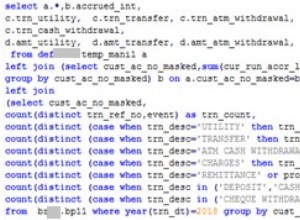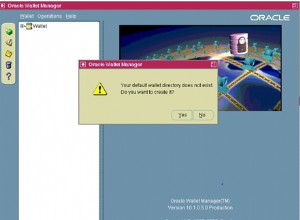Dieser Code ist ziemlich lang. Ich entschuldige mich. Es besteht aus zwei gespeicherten Prozeduren. Sie können zufrieden sein, wenn Sie nur den ersten ausführen. Die zweite verwendet die Ausgabe der ersten (die Daten, die die erste in Tabellen hinterlassen hat). Sie können den Code auch zu einem kombinieren. Aber ich habe sie getrennt gehalten. Die zweite gespeicherte Prozedur erzeugt eine Ausgabe, die describe myTable ähnelt . Aber es führt es für ALLE durch Tabellen in der Datenbank, die Sie eine solche Ausgabe wünschen.
Sie verwenden dies, indem Sie einen Parameter (String) für die zu meldende Datenbank übergeben.
Ich erstelle eine separate Datenbank, und der Code verweist explizit namentlich auf Tabellen in dieser Datenbank. Wenn Sie also EXECUTE haben Zugriffsrechte auf diese gespeicherte Prozedur haben, können Sie sie von jeder aktuellen Datenbank aus ausführen. Legen Sie also als einfachen Test die Berichtsdatenbank nicht als Ihre aktuelle Datenbank fest, und rufen Sie die gespeicherte Prozedur lediglich nach Namen auf (qualifiziert mit dem Namen der Berichtsdatenbank). Dies alles wird im Test-Chunk unten gezeigt.
Zwei gespeicherte Prozeduren
CREATE SCHEMA Reporting101a; -- See **Note1**
DROP PROCEDURE IF EXISTS `Reporting101a`.`describeTables_v2a`;
DELIMITER $$
CREATE DEFINER=`root`@`localhost` PROCEDURE `Reporting101a`.`describeTables_v2a`(
IN dbName varchar(100), -- the dbname to report table structures
OUT theSession int, -- OUT parameter for session# assigned
IN deleteSessionRows BOOL, -- true for delete rows when done from main reporting table for this session#
IN callTheSecondStoredProc BOOL -- TRUE = output is from Pretty output in Second Stored Proc. FALSE= not so pretty output
)
BEGIN
DECLARE thisTable CHAR(100);
DROP TEMPORARY TABLE IF EXISTS Reporting101a.tOutput;
CREATE TEMPORARY TABLE Reporting101a.tOutput
( id int auto_increment primary key,
tblName varchar(100) not null,
ordVal int not null,
cField varchar(100) not null,
cType varchar(100) not null,
cNull varchar(100) not null,
cKey varchar(100) not null,
cDefault varchar(100) null,
cExtra varchar(100) null
);
DROP TEMPORARY TABLE IF EXISTS Reporting101a.tOutput2;
CREATE TEMPORARY TABLE Reporting101a.tOutput2
( tblName varchar(100) primary key,
colCount int not null,
cFieldMaxLen int not null,
cTypeMaxLen int not null,
cNullMaxLen int not null,
cKeyMaxLen int not null,
cDefaultMaxLen int not null,
cExtraMaxLen int not null
);
INSERT Reporting101a.tOutput(tblName,ordVal,cField,cType,cNull,cKey,cDefault,cExtra)
SELECT TABLE_NAME,ORDINAL_POSITION,COLUMN_NAME AS Field, COLUMN_TYPE AS TYPE, RPAD(IS_NULLABLE,4,' ') AS 'Null',
RPAD(COLUMN_KEY,3,' ') AS 'Key',RPAD(COLUMN_DEFAULT,7,' ') AS 'DEFAULT',EXTRA AS Extra
FROM information_schema.columns WHERE table_schema = dbName ORDER BY table_name,ordinal_position;
-- select * from information_schema.columns WHERE table_schema = '57security' order by table_name,ordinal_position;
UPDATE Reporting101a.tOutput
SET cExtra=' '
WHERE cExtra='';
UPDATE Reporting101a.tOutput
SET cField=RPAD(cField,5,' ')
WHERE LENGTH(cField)<5;
INSERT Reporting101a.tOutput2(tblName,colCount,cFieldMaxLen,cTypeMaxLen,cNullMaxLen,cKeyMaxLen,cDefaultMaxLen,cExtraMaxLen)
SELECT tblName,COUNT(*),0,0,0,0,0,0
FROM Reporting101a.tOutput
GROUP BY tblName;
UPDATE tOutput2 t2
JOIN
( SELECT tblName,MAX(LENGTH(cField)) AS mField,MAX(LENGTH(cType)) AS mType,MAX(LENGTH(cNull)) AS mNull,
IFNULL(MAX(LENGTH(cKey)),0) AS mKey,IFNULL(MAX(LENGTH(cDefault)),0) AS mDefault,IFNULL(MAX(LENGTH(cExtra)),0) AS mExtra
FROM Reporting101a.tOutput
GROUP BY tblName
) x
ON x.tblName=t2.tblName
SET t2.cFieldMaxLen=x.mField,t2.cTypeMaxLen=x.mType,cNullMaxLen=x.mNull,
cKeyMaxLen=x.mKey,cDefaultMaxLen=x.mDefault,cExtraMaxLen=x.mExtra;
-- DROP TABLE Reporting101a.reportDataDefsSession; -- useful for quick change of structure of table
-- note, keep above drop call remmed out ! Just use it for quick tweaks to structure
CREATE TABLE IF NOT EXISTS Reporting101a.reportDataDefsSession
( -- for the sole purpose of safe session auto_inc usage
-- Please don't delete unless you want the sessions to experience aberant behavior
sessionId INT AUTO_INCREMENT PRIMARY KEY,
dummy CHAR(1) NOT NULL,
creationDT datetime not null
);
CREATE TABLE IF NOT EXISTS Reporting101a.reportDataDefs
( sessionId INT NOT NULL,
tblName VARCHAR(100) NOT NULL, -- Tablename
ordVal INT NOT NULL, -- the "position number" of the Column
cField VARCHAR(100) NOT NULL, -- The Column
cType VARCHAR(100) NOT NULL, -- Datatype
cNull VARCHAR(100) NOT NULL, -- Nullability
cKey VARCHAR(100) NOT NULL, -- Key info
cDefault VARCHAR(100) NULL, -- Default value
cExtra VARCHAR(100) NULL, -- Extra output
colCount INT NOT NULL, -- the columns here and below are de-normalize data
cFieldMaxLen INT NOT NULL,
cTypeMaxLen INT NOT NULL,
cNullMaxLen INT NOT NULL,
cKeyMaxLen INT NOT NULL,
cDefaultMaxLen INT NOT NULL,
cExtraMaxLen INT NOT NULL
);
-- For lack of a better notion, we are calling calls "sessions". The programmer calls the
-- First Stored Proc, and we call that a session after we get a unique next incrementing number.
-- That number is the session #. House all output with that as a column value. This allows us to
-- move between stored procs, have safe output, have historical snapshots, and retain the data
-- via a session # for later use, whatever use.
INSERT Reporting101a.reportDataDefsSession(dummy,creationDT) VALUES ('X',now());
SET @mySession=LAST_INSERT_ID(); -- there it is, our session # (read the above paragraph)
INSERT Reporting101a.reportDataDefs(sessionId,tblName,ordVal,cField,cType,cNull,cKey,cDefault,cExtra,
colCount,cFieldMaxLen,cTypeMaxLen,cNullMaxLen,cKeyMaxLen,cDefaultMaxLen,cExtraMaxLen)
SELECT @mySession,t1.tblName,t1.ordVal,t1.cField,t1.cType,t1.cNull,t1.cKey,t1.cDefault,t1.cExtra,
t2.colCount,t2.cFieldMaxLen,t2.cTypeMaxLen,t2.cNullMaxLen,t2.cKeyMaxLen,t2.cDefaultMaxLen,t2.cExtraMaxLen
FROM Reporting101a.tOutput t1
JOIN Reporting101a.tOutput2 t2
ON t2.tblName=t1.tblName
ORDER BY t1.tblName,t1.id;
DROP TEMPORARY TABLE Reporting101a.tOutput;
DROP TEMPORARY TABLE Reporting101a.tOutput2;
SET [email protected]; -- the OUT var that came in as a parameter
-- ***************************************************************************
-- ***************************************************************************
-- Label "Some_Sort_of_Output":
IF callTheSecondStoredProc=TRUE THEN
-- The caller says to call the second stored proc (for Pretty Printing)
-- This will generate output similar to `DESCRIBE myTable`
-- But remember, it will do it for EVERY table in referenced database
CALL Reporting101a.`Print_Tables_Like_Describe`(@mySession);
-- The above call just gave you output.
ELSE
-- The caller chose to not auto call the Pretty Printing second stored procedure.
-- Note, the caller can easily call it right after using the OUT parameter.
-- So our output will be a resultset of out reportDataDefs table for this session #
SELECT *
FROM Reporting101a.reportDataDefs
WHERE [email protected]
ORDER BY tblName,ordVal;
END IF;
-- ***************************************************************************
-- ***************************************************************************
IF deleteSessionRows=TRUE THEN
-- The caller says output rows are NOT needed at this point. Delete them.
-- Note, if this boolean comes in TRUE, you can't call Pretty Printing
-- second stored procedure with the session # because the data is gone.
--
-- Regardless, you are getting something back from "Some_Sort_of_Output" above.
DELETE FROM Reporting101a.reportDataDefs
WHERE [email protected];
END IF;
END$$
DELIMITER ;
DROP PROCEDURE IF EXISTS `Reporting101a`.`Print_Tables_Like_Describe`;
DELIMITER $$
CREATE DEFINER=`root`@`localhost` PROCEDURE `Reporting101a`.`Print_Tables_Like_Describe`(
pSessionId INT
)
BEGIN
DECLARE done INT DEFAULT FALSE;
DECLARE curTable VARCHAR(100) DEFAULT '';
DECLARE bFirst BOOL DEFAULT TRUE;
DECLARE lv_tblName,lv_cField,lv_cType,lv_cNull,lv_cKey,lv_cDefault,lv_cExtra VARCHAR(100);
DECLARE lv_ordVal,lv_colCount,lv_cFieldMaxLen,lv_cTypeMaxLen,lv_cNullMaxLen,lv_cKeyMaxLen,lv_cDefaultMaxLen,lv_cExtraMaxLen INT;
DECLARE cur1 CURSOR FOR SELECT tblName,ordVal,cField,cType,cNull,cKey,cDefault,cExtra,
colCount,cFieldMaxLen,cTypeMaxLen,cNullMaxLen,cKeyMaxLen,cDefaultMaxLen,cExtraMaxLen
FROM Reporting101a.reportDataDefs
WHERE sessionId=pSessionId
ORDER BY tblName,ordVal;
DECLARE CONTINUE HANDLER FOR NOT FOUND SET done = TRUE;
-- Please note in the above, CURSOR stuff must come last else "Error 1337: Variable or condition decl aft curs"
CREATE TABLE IF NOT EXISTS Reporting101a.reportOutput
( lineNum INT AUTO_INCREMENT PRIMARY KEY,
sessionId INT NOT NULL,
lineOut varchar(100) NOT NULL
);
-- INSERT Reporting101a.reportOutput(sessionId,lineOut)
-- SELECT
-- SET curTable='';
DELETE FROM Reporting101a.reportOutput
WHERE sessionId=pSessionId;
OPEN cur1;
read_loop: LOOP
FETCH cur1 INTO lv_tblName,lv_ordVal,lv_cField,lv_cType,lv_cNull,lv_cKey,lv_cDefault,lv_cExtra,
lv_colCount,lv_cFieldMaxLen,lv_cTypeMaxLen,lv_cNullMaxLen,lv_cKeyMaxLen,lv_cDefaultMaxLen,lv_cExtraMaxLen ;
IF done THEN
LEAVE read_loop;
END IF;
IF lv_tblName<>curTable THEN
IF bFirst=FALSE THEN
INSERT Reporting101a.reportOutput(sessionId,lineOut)
SELECT pSessionId,'';
ELSE
SET bFirst=FALSE;
END IF;
INSERT Reporting101a.reportOutput(sessionId,lineOut)
SELECT pSessionId,lv_tblName;
INSERT Reporting101a.reportOutput(sessionId,lineOut)
SELECT pSessionId,CONCAT('+-',
REPEAT('-',GREATEST(5,lv_cFieldMaxLen)), '-+-',
REPEAT('-',GREATEST(4,lv_cTypeMaxLen)), '-+-',
REPEAT('-',GREATEST(4,lv_cNullMaxLen)), '-+-',
REPEAT('-',GREATEST(3,lv_cKeyMaxLen)), '-+-',
REPEAT('-',GREATEST(7,lv_cDefaultMaxLen)), '-+-',
REPEAT('-',GREATEST(5,lv_cExtraMaxLen)), '-+');
SET @dashLineNumRow=LAST_INSERT_ID();
INSERT Reporting101a.reportOutput(sessionId,lineOut)
SELECT pSessionId,CONCAT('| ',
'Field',
REPEAT(' ',GREATEST(0,lv_cFieldMaxLen-5)), ' | ',
'Type',
REPEAT(' ',GREATEST(0,lv_cTypeMaxLen-4)), ' | ',
'Null',
REPEAT(' ',GREATEST(0,lv_cNullMaxLen-4)), ' | ',
'Key',
REPEAT(' ',GREATEST(0,lv_cKeyMaxLen-3)), ' | ',
'Default',
REPEAT(' ',GREATEST(0,lv_cDefaultMaxLen-7)), ' | ',
'Extra',
REPEAT(' ',GREATEST(0,lv_cExtraMaxLen-5)), ' |');
INSERT Reporting101a.reportOutput(sessionId,lineOut)
SELECT pSessionId,lineOut
FROM Reporting101a.reportOutput
WHERE [email protected];
-- SELECT * FROM Reporting101a.reportDataDefs WHERE sessionId=24;
SET curTable=lv_tblName;
END IF;
INSERT Reporting101a.reportOutput(sessionId,lineOut)
SELECT pSessionId,
CONCAT('| ',
COALESCE(lv_cField,''),
COALESCE(REPEAT(' ',GREATEST(0,lv_cFieldMaxLen-LENGTH(lv_cField))),''),' | ',
COALESCE(lv_cType,''),
COALESCE(REPEAT(' ',GREATEST(0,lv_cTypeMaxLen-LENGTH(lv_cType))),''),' | ',
COALESCE(lv_cNull,''),
COALESCE(REPEAT(' ',GREATEST(0,lv_cNullMaxLen-LENGTH(lv_cNull))),''),' | ',
COALESCE(lv_cKey,' '),
COALESCE(REPEAT(' ',GREATEST(0,lv_cKeyMaxLen-LENGTH(lv_cKey))),''),' | ',
COALESCE(lv_cDefault,' '),
COALESCE(REPEAT(' ',GREATEST(0,lv_cDefaultMaxLen-LENGTH(lv_cDefault))),''),' | ',
COALESCE(lv_cExtra,' '),
COALESCE(REPEAT(' ',GREATEST(0,lv_cExtraMaxLen-LENGTH(lv_cExtra))),''),' |');
INSERT Reporting101a.reportOutput(sessionId,lineOut)
SELECT pSessionId,lineOut
FROM Reporting101a.reportOutput
WHERE [email protected];
END LOOP;
CLOSE cur1;
select lineOut as '' from Reporting101a.reportOutput where sessionId=pSessionId order by lineNum;
END$$
DELIMITER ;
Test
Test:
-- See **Note2**
SET @theOutVar =-1; -- A variable used as the OUT variable below
-- See **Note3**
-- Note: with `TRUE` as the 4th parameter, this is a one call deal. Meaning, you are done.
call Reporting101a.describeTables_v2a('stackoverflow',@theOutVar,false,true);
-- See **Note4**
-- Primarily used if the 4th parameter above is false
call Reporting101a.Print_Tables_Like_Describe(@theOutVar); -- loads data for prettier results in chunk format.
Ausgabe
+--------------------------------------------------------------------------------------------+
| |
+--------------------------------------------------------------------------------------------+
| course |
| +------------+--------------+------+-----+---------+----------------+ |
| | Field | Type | Null | Key | Default | Extra | |
| +------------+--------------+------+-----+---------+----------------+ |
| | courseId | int(11) | NO | PRI | | auto_increment | |
| +------------+--------------+------+-----+---------+----------------+ |
| | deptId | int(11) | NO | MUL | | | |
| +------------+--------------+------+-----+---------+----------------+ |
| | courseName | varchar(100) | NO | | | | |
| +------------+--------------+------+-----+---------+----------------+ |
| |
| dept |
| +----------+--------------+------+-----+---------+----------------+ |
| | Field | Type | Null | Key | Default | Extra | |
| +----------+--------------+------+-----+---------+----------------+ |
| | deptId | int(11) | NO | PRI | | auto_increment | |
| +----------+--------------+------+-----+---------+----------------+ |
| | deptName | varchar(100) | NO | | | | |
| +----------+--------------+------+-----+---------+----------------+ |
| |
| scjunction |
| +------------+---------+------+-----+---------+----------------+ |
| | Field | Type | Null | Key | Default | Extra | |
| +------------+---------+------+-----+---------+----------------+ |
| | id | int(11) | NO | PRI | | auto_increment | |
| +------------+---------+------+-----+---------+----------------+ |
| | studentId | int(11) | NO | MUL | | | |
| +------------+---------+------+-----+---------+----------------+ |
| | courseId | int(11) | NO | MUL | | | |
| +------------+---------+------+-----+---------+----------------+ |
| | term | int(11) | NO | | | | |
| +------------+---------+------+-----+---------+----------------+ |
| | attendance | int(11) | NO | | | | |
| +------------+---------+------+-----+---------+----------------+ |
| | grade | int(11) | NO | | | | |
| +------------+---------+------+-----+---------+----------------+ |
| |
| student |
| +-----------+--------------+------+-----+---------+----------------+ |
| | Field | Type | Null | Key | Default | Extra | |
| +-----------+--------------+------+-----+---------+----------------+ |
| | studentId | int(11) | NO | PRI | | auto_increment | |
| +-----------+--------------+------+-----+---------+----------------+ |
| | fullName | varchar(100) | NO | | | | |
| +-----------+--------------+------+-----+---------+----------------+ |
| |
| testtable |
| +-----------------------------------------+---------------+------+-----+---------+-------+ |
| | Field | Type | Null | Key | Default | Extra | |
| +-----------------------------------------+---------------+------+-----+---------+-------+ |
| | noPKhere | int(11) | NO | | | | |
| +-----------------------------------------+---------------+------+-----+---------+-------+ |
| | veryLongColumnName_And_Then.Some_%_More | decimal(12,2) | YES | | | | |
| +-----------------------------------------+---------------+------+-----+---------+-------+ |
| | limit | int(11) | NO | | | | |
| +-----------------------------------------+---------------+------+-----+---------+-------+ |
| |
| testtable2 |
| +-------+---------+------+-----+---------+-------+ |
| | Field | Type | Null | Key | Default | Extra | |
| +-------+---------+------+-----+---------+-------+ |
| | id | int(11) | NO | PRI | | | |
| +-------+---------+------+-----+---------+-------+ |
+--------------------------------------------------------------------------------------------+
Anmerkung1 :Eine Datenbank namens Reporting101a wird erstellt, um zwei gespeicherte Prozeduren und einige Hilfstabellen aufzunehmen. Diese Routinen beginnen mit dem Aufruf einer gespeicherten Prozedur, die sich auf die zu meldende Datenbank bezieht durch Verwendung einer Zeichenfolge.
Auf die Daten zur Erzeugung der Ausgabe wird über den speziellen INFORMATION_SCHEMA zugegriffen Datenbank auf schreibgeschützte sichere Weise. Daher wird die Datenbank, über die berichtet wird, nicht berührt.
In dieser Datenbank werden drei nicht-temporäre Tabellen aufbewahrt.
reportDataDefsSession- Eine einfache Tabelle zum Abrufen einer Sitzung#reportDataDefs- Datenrückgabe vonINFORMATION_SCHEMAund etwas massiert. Es ist sitzungsbasiert.reportOutput- Eine Tabelle zum Ausdrucken wieDESCRIBEvon MySQL . Es ist nur eine Tabelle zum Zusammenstellen der Ausgabe. Es ist sitzungsbasiert.
Anmerkung2 :Dieser INT Variable wird als OUT eingebunden Parameter target, in den geschrieben wird, und ermöglicht es Ihnen, Ihren anderen Code einzufügen, nachdem die erste gespeicherte Prozedur die Daten vorbereitet hat. Es stellt eine Sitzungsnummer dar, die die Ausgabe für spätere Berichte isoliert.
Einige Umgebungen wie PHP haben bestimmte Tricks, die dies für einige Programmierer zu einem Hingucker machen. Wenn Sie also beide gespeicherten Prozeduren selbst kombinieren müssen, tun Sie dies (oder fragen Sie mich separat, wenn Sie verwirrt sind).
Auf jeden Fall zeigt es, wie Daten oder Bemühungen gespeicherte Prozeduraufrufe miteinander verketten können.
Ehrlich Einer der Hauptgründe, warum ich eine Sitzungsnummer als OUT-Parameter verwende, ist, dass ich weiß, dass ich einen CURSOR erstellen muss, um die hübsche Ausgabe zu erhalten. Und das erfordert ein Cursor DECLARE
am Anfang einer zweiten gespeicherten Prozedur. Und DECLARE s muss am Anfang einer gespeicherten Prozedur stehen. Also ging ich mit gebundenen Händen diesen Weg.
Anmerkung 3 :Dies ist der Aufruf der ersten gespeicherten Prozedur. Es ist sehr wahrscheinlich, dass Sie nach diesem Aufruf mit TRUE als viertem Parameter fertig sind. Die gespeicherte Prozedur ist darin ziemlich gut dokumentiert. Der dritte Parameter gibt an, ob die Daten aus der Berichtstabelle für die Sitzungsnummer gelöscht werden sollen oder nicht. Das Löschen erfolgt nach jeder Ausgabe als Ergebnismenge. Das hängt also von Ihrer Wahl ab.
Parameter:
- der Datenbankname zur Beschreibung aller Tabellen wie
describe myTable - der
INTOUTParameter zum Halten der Sitzung # - Boolesch:Sollen die Daten am Ende aus der Berichtstabelle gelöscht werden
- boolesch:Sollen wir automatisch die gespeicherte Prozedur zum hübschen Drucken aufrufen, die
describegeneriert -ähnliche Ausgabe. Wenn Sie sich entscheiden, Parameter 4 alsFALSEzu übergeben , dann könnte Ihre Ausgabe so aussehen:
Anmerkung4 :Wird in Fällen verwendet, in denen Sie eine andere Ausgabe wünschen, aber mit der Sitzungsnummer arbeiten möchten. Normalerweise brauchen Sie das nicht.





